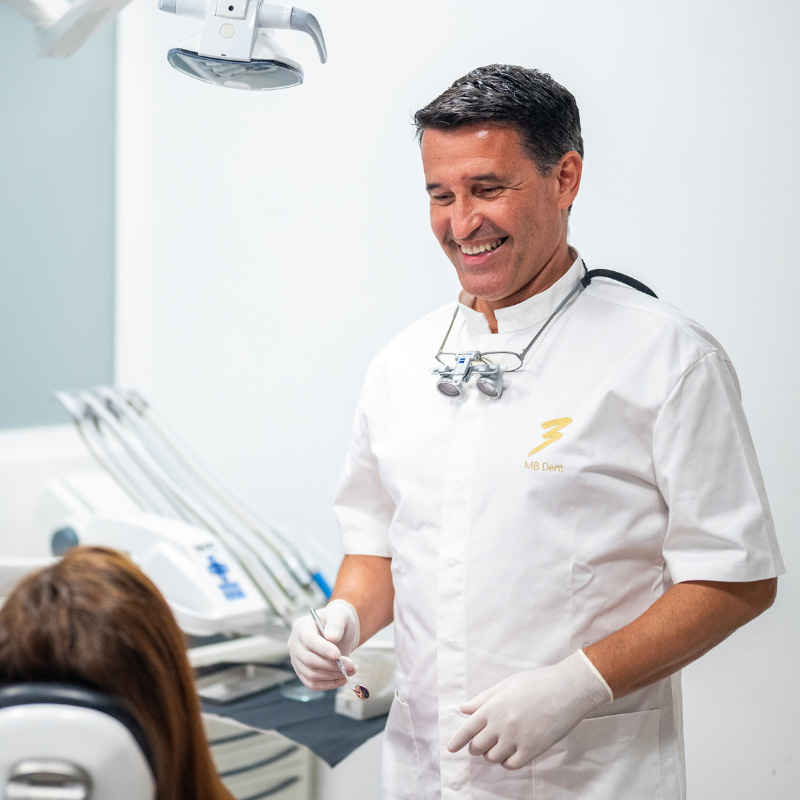Teeth whitening is a painless procedure during which impurities and stains on the surface of the teeth are removed. The process lasts about an hour, and the goal is to achieve an individual optimum of whiteness that looks natural.
The results of tooth whitening are very subjective and can significantly vary from person to person. Before you decide on any whitening procedure, consult with your dentist about the realistic prognosis, i.e., real expectations and the time it will take.
What is teeth whitening?
Tooth whitening is a dental procedure used to lighten the colour of teeth, achieving a brighter and whiter smile. This procedure is often applied to individuals who want to reduce tooth discolouration caused by ageing, smoking, consuming dark colored drinks and food, or using certain medications.
When is teeth whitening used?
Teeth whitening is used in different situations to achieve a brighter and whiter smile. Some situations where tooth whitening is applied:
- Teeth colour change: Whitening is most commonly used to reduce tooth discolouration caused by ageing, consumption of coffee, tea, red wine, tobacco, or other dark beverages and foods.
- Stains on teeth: If the teeth are discolored or have stains, whitening can help remove or reduce these stains, achieving a more even tooth colour.
- Special occasions: Many people choose to whiten their teeth before special occasions such as weddings, celebrations, or important events to have a smile that is brighter and more attractive.
- Confidence boost: A brighter smile can contribute to greater self-confidence and a better feeling about one’s appearance.
- Restoration after treatments: After treatments that have changed the tooth colour, such as root canal treatment or removal of fillings, whitening can be used to align the tooth colour with surrounding teeth.
- Otherwise healthy teeth: Whitening is usually suitable for otherwise healthy teeth without serious problems like cavities or gum disease.
Some teeth may be less suitable for whitening, such as teeth with damaged enamel, dental crowns, bridges, or implants. Before you decide to whiten your teeth, it is recommended to visit a dentist to assess whether whitening is suitable for your specific situation and to achieve the best result.
What types of teeth whitening are there?
There are different types of teeth whitening, which can be divided based on the method of application and location of whitening.
- 1. Home whitening:
- Whitening with a customized tray: Similar to strips, the dentist will create a customized tray filled with whitening gel. The tray is placed on the teeth and worn for a specific amount of time according to instructions.
- Home whitening with gel: The dentist will provide you with a whitening gel that you apply to the teeth using a special applicator. This process requires precise following of the dentist’s instructions to achieve the desired result.
- 2. Inside the clinic whitening:
- Light-activated whitening: The dentist applies whitening gel to the teeth and activates it with light or laser energy to achieve a brighter result more quickly. This method is usually performed in one or two visits to the dental office.
- Combined whitening: Sometimes, a combination of home and in-office whitening is used to achieve the optimal result. The patient wears custom-made strips or trays at home and also undergoes a whitening procedure in the dental office.
- Internal whitening: Used when tooth discolouration is caused by internal factors such as injuries or root inflammation. The dentist applies inside the tooth and seals it, allowing it to act for several days.
The choice of whitening type depends on your needs, desires, and recommendations of the dentist. Regardless of the type, it is important to follow the dentist’s instructions to achieve a safe and effective whitening result.
The teeth whitening procedure
The teeth whitening procedure can vary depending on the type of whitening you choose, but here’s the process for home whitening and in-office light-activated whitening:
At Home teeth whitening:
- Consultation with the dentist: The first step is a consultation with the dentist to assess your situation and determine if whitening is suitable for you.
- Tooth impression: The dentist will take an impression of your teeth to create customized strips or a tray.
- Making customized strips or a tray: Based on the impression, customized strips or a tray are made that will precisely fit your teeth.
- Instructions for use: The dentist will explain in detail how to properly use the strips or tray and how to apply the whitening gel.
- Home whitening: You wear the strips or tray at home according to the dentist’s instructions, usually for several hours a day or at night, for a specific period recommended.
- Monitoring progress: During the use of the strips or tray, you may notice gradual lightening of the tooth color. You will regularly consult with the dentist to monitor the achievement of desired results.
In clinic teeth whitening:
- Preparation: The dentist will protect the gums and oral cavity to avoid irritation during the procedure.
- Applying whitening gel: The dentist will apply the whitening gel to the teeth.
- Light activation: Light or laser energy is used to activate the gel and speed up the whitening process.
- Repeating the process: Depending on the desired result, the process of applying the gel and light activation may be repeated several times.
- Final assessment: After completing the procedure, the dentist will assess the achieved result and provide you with advice for maintenance.
Are there any side effects of teeth whitening?
Tooth whitening is a safe procedure, but as with any medical treatment, side effects are possible.
- Tooth sensitivity: After whitening, teeth may become temporarily sensitive to cold, hot, or sweet. This sensitivity usually passes after a few days or weeks.
- Gum irritation: Whitening gel can cause irritation or sensitivity of the gums. This usually occurs if the gel comes in contact with the gums during the procedure.
- Uneven whitening: Sometimes, teeth may not achieve even whitening, which can result in spots or uneven colour.
- Colour changes: In rare cases, tooth colour may become uneven or even acquire a bluish tone if whitening is not performed correctly.
- Enamel damage: Excessive or improper whitening can lead to enamel damage, making teeth more sensitive and prone to cavities.
- Undesirable results: Whitening can have different results for different people, and although the goal is to achieve a brighter smile, sometimes the achieved result is not as expected.
- Colour relapse: Colour may return to its natural tone over time due to diet, smoking, or other external factors.
Side effects are relatively rare, and most people do not have problems after tooth whitening.
Regular oral hygiene maintenance and dental visits are also important for maintaining the health and appearance of your teeth after whitening.
Warranty
Lifetime warranty on all implants and superstructures against breakage.
Five years warranty on all metal-ceramic and zircon-ceramic crowns.
Five years warranty on all wironit dentures.

Prices
The price for full Teeth Whitening in our dental clinic is 347 Euro.
For any additional information, follow the blogs of the MB Dent clinic. If you would like more information from Dr. Matko Božić and his team, write to us at info@mbdent.com, WhatsApp 095 3634 337, or call us on the phone number 01 35 35 435 or mobile 095 3634 337.


